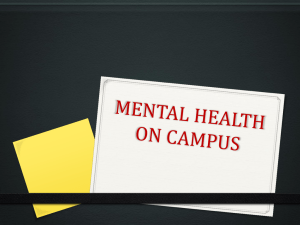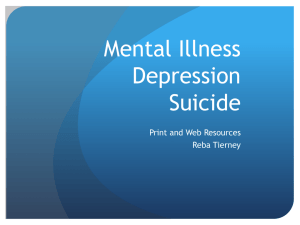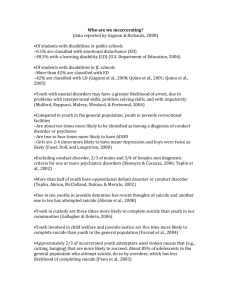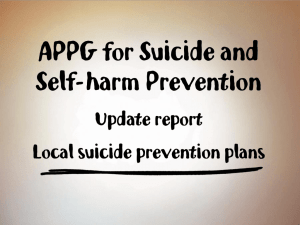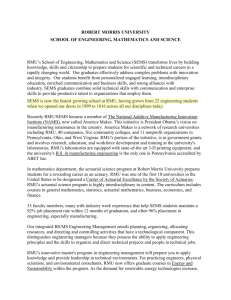the PowerPoint
advertisement
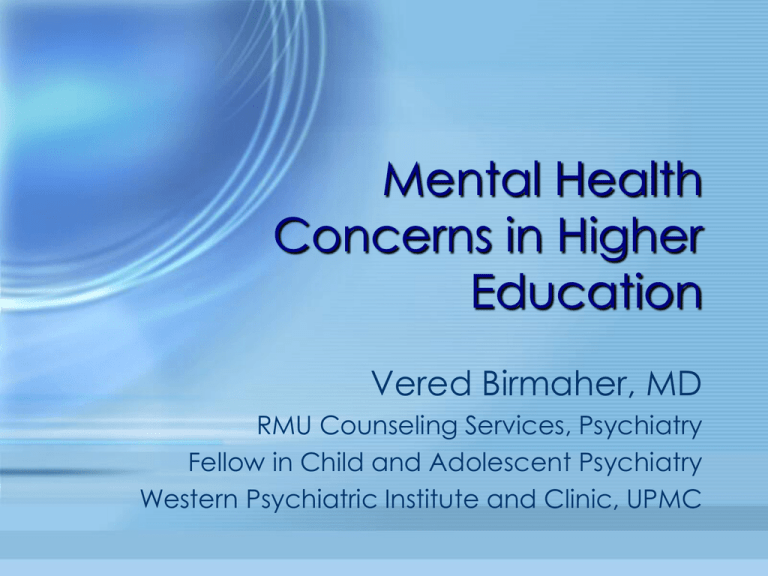
Mental Health Concerns in Higher Education Vered Birmaher, MD RMU Counseling Services, Psychiatry Fellow in Child and Adolescent Psychiatry Western Psychiatric Institute and Clinic, UPMC Outline • How prevalent is mental illness among college students? • What are the common diagnoses? • What causes mental illness? • What are the treatment options? • What might I see in the classroom? • What is the role of faculty? • What is the RMU referral process? • How do I approach a student? How prevalent is mental illness among college students? • 1 out of 4 college students suffers from some form of diagnosable mental illness. • 44 percent of college students reported symptoms of depression. – 62% reported feeling very sad – 30% felt so depressed it was difficult to function – 45% felt things were hopeless • 45 % reported overwhelming anxiety • 36 % reported overwhelming anger • 17 % reported interpersonal violence • Over 66 % of those with a substance use disorder have a co-occurring mental health diagnosis • 5 million young females suffer from eating disorders each year, the deadliest mental illness • Of students that dropped out of college, 64% said mental health was the major cause. – Of those, 45% did not receive accommodations for various reasons – 50% did not access mental health support – Others lost financial aid/scholarships due to low GPA or changing to parttime student status • Suicide is a leading cause of death among youth – 3rd leading cause in ages 15-24 – 2nd leading cause in ages 20-24 • Yearly, at least 7 % of students report contemplating suicide and 1.5 % report attempting suicide What are the common diagnoses? Depression • Sadness • Loss of interest in activities • Feelings of guilt • Poor concentration • Low energy • Changes in appetite and/or weight • Poor or excessive sleep • Hopelessness • Thoughts of death or suicide Associated symptoms • Irritability • Tearfulness • Anxiety • Pain Generalized Anxiety Disorder • Persistent, significant worries with ongoing, severe tension • Feeling helpless to control these worries • Worries can focus on job responsibilities, family health, or minor matters such as chores, car repairs, or appointments • Many associated physical symptoms Attention Deficit Hyperactivity Disorder • Inattentiveness, distractibility, problems with concentration • Impulsivity • Hyperactivity - may manifest as fidgeting in this age group Other disorders • • • • • • • • Social Anxiety Disorder Panic disorder Obsessive-Compulsive Disorder Posttraumatic Stress Disorder Bipolar Disorder Schizophrenia Substance Use Disorders Eating Disorders What causes mental illness? Depression is a BIOLOGICAL illness What are the treatment options? Over two-thirds of young people do not talk about or seek help for mental health problems. 80-90 percent of people that seek the necessary form of mental health treatment can function the way they used to. Treatment • Bolster family, social, religious supports • Relaxation, stress management • Exercise, healthy eating • Provide academic supports • Therapy • Substance abuse treatment • Medication management What might I see in the classroom? The Suddenly Empty Chair He only missed one day of class. As an instructor, when you look at your roster and see exemplary attendance, one day usually doesn't raise concern. But there's always that little voice in the back of your mind. The one that says, "This kid has record attendance. He's never missed a quiz or an assignment. E-mails when he's going to be late. Apologizes when he is. I hope he's OK." Marguerite Choi Academic Signs • • • • Repeated absences or missed work Deterioration in quality or quantity of work Disorganization or erratic performance Written or artistic expression of unusual violence, morbidity, social isolation, despair, confusion, thoughts of suicide or death • Continual seeking of special provisions • Patterns of perfectionism- must get A’s, overblown or disproportionate response to grades or other evaluations Emotional Signs • Direct statements indicating distress, family problems, trauma, loss, etc • Angry outbursts, yelling, or aggressive comments • More withdrawn than usual • Expressions of hopelessness or worthlessness • Crying or tearfulness • Severe anxiety or irritability • Distractibility, problems with concentration • Excessively demanding or dependent behavior • Lack of response to outreach from course staff Physical Signs • Deterioration in physical appearance or personal hygiene • Excessive fatigue, falling asleep in class • Visible changes in weight • Noticeable cuts, bruises, or burns • Frequent or chronic illness • Shaking, tremors, fidgeting, or pacing • Confusion; disorganized or rapid speech • Coming to class under the influence Safety Risk Indicators • Written or verbal statements that mention despair, suicide, or death • Severe hopelessness, depression, isolation, and withdrawal • Statements to the effect that the student is going away for long time • Statements that mention hurting someone else What can I do? Set a Positive Environment • • • • Get to know your students Foster an open door policy You need only care and listen Be mindful and respectful of mental health issues • Promote collaboration, friendly competition • Discuss time and stress management • Provide constructive feedback Know the Resources • Early alerts form - www.RMU.edu/atrisk – For academic and emotional concerns – The information goes to Cassandra Oden – Any referrals for emotional or mental concerns are passed on to Randon Willard – If needed, Randon then sends students to the therapist for intake and she can refer to MD. • Stop by the Center for Student Success to talk with one of the staff • Know resources for information, support Approaching a Student • Meet privately with the student • Turn off all distractions (cell phone, computer, etc) • Begin the conversation by expressing your concerns about specific behaviors you have observed. • Your role is to listen, support and provide referral sources • Convey hope Helpful phrases • Use I statements: “I’ve noticed lately that …” • Ask open‐ended questions that deal directly with the issues without judging: “How are things going for you?” • “What problems has that situation caused you?” • Listen attentively and encourage the student to talk: “Tell me more about that.” Helpful phrases • Paraphrase what you have heard: “It sounds like x and y have been very stressful for you” • Convey your concern and caring: “What do you need to do to get back on track?” • Help student stay in control: “What do you think would be helpful for you in this situation?” • Discuss potential benefits of resources and referrals: “I know the folks in that office and they are great at helping students work through these kinds of situations.” Referral • Provide contact info for referral resource • Your offer of help may be rejected. Respect student’s autonomy unless you have a concern for danger. • Convey that your referral is due to concern about the student and the knowledge that professional help works. • End the conversation in a way that will allow you or the student to revisit the topic. Invite the student back to follow up and/or check in with student. Lethality Screening • A student who is considering suicide will likely be relieved that you asked. • If the student is not contemplating suicide, asking the question will not put ideas in their head. • If you have an urgent concerns about a student’s safety, stay with the student and call Public Safety • Limits of confidentiality Lethality Screening • “Sometimes people in your situation can feel that life is not worth living anymore. Have you felt this way? • “Have you had thoughts of ending your life?” • “Do you feel that your situation is hopeless?” • “Have you done anything to hurt yourself in any way?” • “As depression worsens, people can become hopeless and think of suicide. Has that happened to you?” Emergencies • If a student is in imminent danger of harming self or others, stay with the student and immediately call Public Safety at (412) 397-2424 – Safety will transport to Sewickley Valley Hospital Emergency Room for evaluation – This student is not appropriate for referral to us and needs more intensive care immediately • ReSolve Crisis Network can also provide support and even send a team to help 1-888-7YOUCAN Websites http://www.RMU.edu/AtRisk • Faculty information about warning signs, how to approach students, how to refer students, resources. Fill out the Early Intervention Referral Form for both personal and academic student issues • • • • • http://www.gannett.cornell.edu/notice http://www.jedfoundation.org http://nami.org -- especially NAMI on Campus http://www.nimh.nih.gov/health/index.shtml http://www.samhsa.gov Contact information Vered Birmaher, MD Psychiatry, RMU Counseling Services Fellow in Child and Adolescent Psychiatry Western Psychiatric Institute and Clinic, UPMC RMU Birmaher@rmu.edu 412-397-4349 WPIC Birmaherv@upmc.edu 412-586-9153
